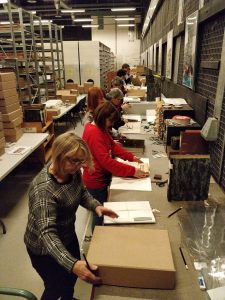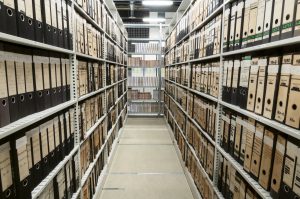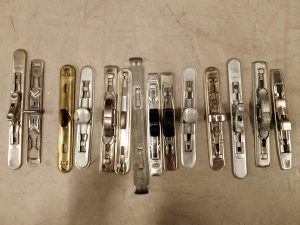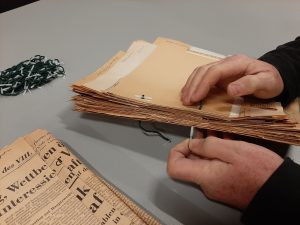January 22, 2020, by Kathryn Steenson
The Cold War in the Cold Store
In the week before Christmas Manuscripts and Special Collections’ staff carried out an internal relocation of material and repackaging exercise that involved the entire section. To make this happen we decided to close the library to the public, freeing all staff to work in the library’s archival store. That week we donned warm layers and all the reindeer jumpers of Christmas past, present and yet to come to sustain us in the climate-controlled environment. The store temperature has a set point of 18.5˚C which certainly is ideal for archives and rare books but rather chilly for humans. Thus prepared – and looking forward – to work in the northernmost reaches of the KMC, we approached our task: to move the newspaper cuttings archive of the British Military Government in Berlin into archival boxes and shelve them horizontally onto larger size shelves.

The news cuttings were wrapped in archival packaging and the information on the labels copied onto the new folders.
The task itself brought us face to face with a different kind of cold. We found ourselves in the middle of the Cold War, removed to a divided Germany, 1946 to 1981.
The BMGB was founded in Allied-occupied Germany and carried out its work throughout the Cold War until the official withdrawal of Allied troops in 1994. In the Cold War the BMGB monitored the German press systematically and undertook the creation of a press digest for the two Germanies, east and west. Every day staff in the BMGB took to their scissors and cut newspaper articles out of German papers. They focused on distinct topics, dedicating new folders year after year to the same topic headings. They filed hundreds of thousands of articles by topic into Leitz lever arch folders. Over the years the BMGB amassed 2,800 files, each file containing an average of a hundred articles. In our store stacks Leitz folders formed themselves into solid walls. Removing them to a new shelving arrangement file by file was not dissimilar to relocating a prefab block of flats slab by slab or rolling a sleeping giant over its side.
The scale of the accumulation raises the question: why did the BMGB collect newspaper articles? One possible reason is that information was strategic in the Cold War and having files ready with all the news about government policies, industrial developments or social problems, offered up the intelligence that a search engine hit list gives us today. From its headquarters in West Berlin the BMGB zoomed in on the media of the other Germany, the GDR, though FRG newspapers are also represented. Today the big newspapers, from which the articles were harvested, have been digitised and can be searched online. However, the structure of the BMGB archive, its topic headings and the selection of articles chosen to flesh them out, can only be found here.
The repackaging and removal has brought the BMGB archive in line with current conservation standards and prolonged the life of the stories it tells. Under the guidance of the Conservator the metal leaver arch mechanisms have been replaced with treasury tags, the articles have been wrapped in acid free paper, bound with linen tape and thus bundled laid flat in archive boxes. These are larger than the original Leitz folders and needed to be located on a larger set of shelves in the store.
Readers are welcome to search the BMGB archive as before using the Subject Index. The collection is fully serviceable for production to the Reading Room. Please email mss.library@nottingham.ac.uk to make an appointment. More information about how to get here or our other collections is available from our website.
This post was written by Ursula, Special Collections Librarian.
No comments yet, fill out a comment to be the first






Leave a Reply